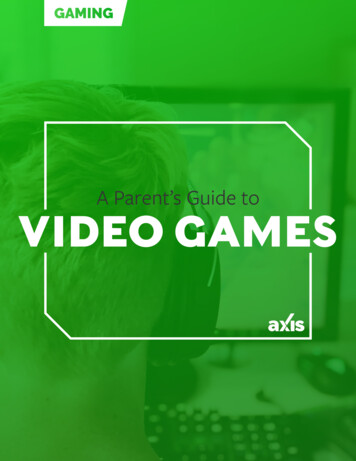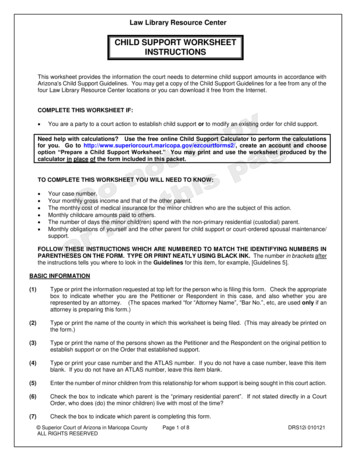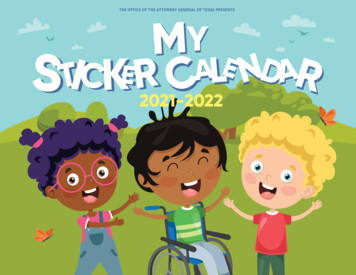
Transcription
GAMINGA Parent’s Guide toVIDEO GAMES
A Parent’s Guide toVIDEO GAMESContents (click to jump to section)Game on. . . . . . . . . . . . . . . . . . . . . . . . . . . . . . . . . . . . . . . . . . . . . . . . . . . 1What terms/slang should I know?. . . . . . . . . . . . . . . . . . . . . . . . . . . . . 1Why do teens love video games?. . . . . . . . . . . . . . . . . . . . . . . . . . . . . . 3Does gaming still appeal mainly to males?. . . . . . . . . . . . . . . . . . . . . . 4How do the ratings work?. . . . . . . . . . . . . . . . . . . . . . . . . . . . . . . . . . . . 4Video games aren’t good for my teen, right? . . . . . . . . . . . . . . . . . . . 5What are the biggest struggles around video games?. . . . . . . . . . . . 5How can I keep my teen’s gaming healthy?. . . . . . . . . . . . . . . . . . . . . 7When should I start worrying?. . . . . . . . . . . . . . . . . . . . . . . . . . . . . . . . 9How should I handle unhealthy gaming? . . . . . . . . . . . . . . . . . . . . . . . 10Final thoughts. . . . . . . . . . . . . . . . . . . . . . . . . . . . . . . . . . . . . . . . . . . . . . 10Related Axis Resources . . . . . . . . . . . . . . . . . . . . . . . . . . . . . . . . . . . . . . 11Additional Resources. . . . . . . . . . . . . . . . . . . . . . . . . . . . . . . . . . . . . . . . 11Recap . . . . . . . . . . . . . . . . . . . . . . . . . . . . . . . . . . . . . . . . . . . . . . . . . . . . . 13Discussion Questions. . . . . . . . . . . . . . . . . . . . . . . . . . . . . . . . . . . . . . . . 14
Game onFew topics in today’s media-saturated world can get a parent or teacher ranting likekids and video gaming. According to Pew Research Center, 72% of teens have playedvideo games in the last year, and they only represent 28% of the video-game-playingpopulation. The video gaming world often represents unknown territory to parents,though, and their attempts to enforce boundaries and limits on their gaming kidstypically end in tension and conflict.Video games developed a bad reputation among child psychologists in the 1980s andafter, when home gaming first became affordable for the average family. Most of theadvice given to parents was anecdotal; child behaviorists and teachers worried aboutwhat appeared to be a glazed-eye of gaming young people. As video game technologyvastly improved toward the century’s end, gaming options exploded from simple,pixelated viewing and simplistic goals to intricately animated universes, awe-inspiringdigital effects, full musical scores, A-list voiceover talent, and vastly more complicatedobjectives. But the questions and worries they inspire remain.What terms/slang should I know?In order to talk with your gamers about what they love (or to know when to beconcerned by something you overhear while they’re playing), it helps to know a fewterms. Here are the basics:Battle Royale: A game where the player fights against around a hundred other playersto be the last man standing in a Hunger-Games-style brawl (Fortnite: Battle Royale iscurrently the most popular of these. Check out our Parent’s Guide to Fortnite for moreinfo.).Campaign: A series of events or challenges designed to tell a story; also known as“Story Mode.”Carry: When a single player on a team performs exceptionally well, compensating forthe rest of the team’s poor performance (also used in traditional sports).Cheese: To win a game by using a strategy that’s unorthodox, unexpected, or exploitiveBack to Table of Contents1 2019 Axis
of a glitch in a game’s design.COD: Call of Duty—Extremely popular PvP and PvE Realistic FPS.Combos: Combinations, a series of specific button input combinations, learned ormemorized for the optimal effective playing experience.CS:GO: Counterstrike: Global Offensive—Extremely popular PvP Realistic FPS.DLC: DownLoadable Content—A extension or expansion on an existing game that canbe purchased to build onto existing content.FPS: First Person Shooter—A shooter game where the player only sees what thecharacter could see.Gank: To kill another player’s character, particularly if the odds are super uneven (e.g.when your character is level 80 and theirs is level 2).GG or GGWP: Good Game or Good Game, Well Played. Sent after a match toacknowledge the other players’ skills and to display sportsmanship.Guildmates or Clanmates: Other players in one’s online gaming community.IRL: In Real Life.KD or KDA: Kills to Deaths Ratio—In MOBAs and team-oriented games, Assists (whenyou helped a teammate kill an enemy) will also be measured, hence KDA.LAN: Local Area Network.MMO: Massively Multiplayer Online, games with thousands of players in an open world,all playing together.MOBA: Multiplayer Online Battle Arenas, games where you choose a character andbattle for objectives, typically 3–5 players on a team, two teams versus each other.Mod: Modification—Specifically, a change to a game’s code to allow for differentcosmetics or player-created game modes.NPC: Non-Player Character—All characters in a game not controlled by the player or ahuman opponent. The behavior of NPCs is controlled by AI (artificial intelligence).PvE: Player versus Environment—A game or mode focused on defeating NPCs orpuzzles. PvE can apply to single player games as well.PvP: Player versus Player—A game or mode focused on defeating other human players.RPG: Role Playing Games, games where you build a character and adventure in aBack to Table of Contents2 2019 Axis
fantastic landscape, typically with the goal of ‘becoming’ that character, or livingvicariously through that character.Rage-quit: When you get so angry and frustrated that you suddenly quit or turn offthe game (this usually elicits not-so-happy remarks from other players the next timeyou sign back in).Troll: Someone acting in bad faith for their own amusement; can range from makingoff-color jokes to sending explicit or disturbing content in innocent-looking links.Of course, there are many other terms, thanks to online playing and streaming platformslike Twitch. This glossary was helpful, but if there’s one you keep hearing and don’tunderstand, try searching for it online.Why do teens love video games?Games offer challenges and rewards that social media platforms don’t. Teens say theyenjoy gaming as a way to “blow off steam” from the stress of the day—homework,friend dynamics, family weirdness, bullying, chores, picking colleges, choosing careerpaths, getting jobs, etc.More importantly, teens love video games for their narrative element. Today’s gamesare fully immersive experiences that invite players into a dynamic and complex storylinein which they play a part in how the story unfolds. Unlike movies or books that allowyou to experience a story from the outside, video games give “you the control over acharacter and his or her actions to an extent and allow you to experience the story asthat character.” In this way, “video games have become a promising frontier for thecreation of immersive, interactive storytelling. Cutting-edge visuals and audio can painta scene for us and draw us into a new reality,” making our teens feel as if they aren’t justwatching a story unfold, they are actively participating in it.In addition, innovations in game design and platforms now allow teens to socializewhile gaming—they invite friends to play, chat, text, make new friends, work togetherto form team strategies, and satiate their competitive drive (check out our Parent’sGuide to Discord and Parent’s Guide to Twitch for more on the social side of games).And with the explosion of esports, some can even turn what was once considered amind-numbing time waster with no real benefit into a career.Back to Table of Contents3 2019 Axis
Does gaming still appeal mainly to males?In 2015, Pew Research found that 89% of teen boys (ages 13-17) play video games. Anyguesses for the percentage of teen girls that play? You may or may not be surprisedthat 59% of girls play. But that was in 2015. Fast forward three years, and the stats areeven more astounding. In spring 2018, Pew found that 97% of teen boys and 83% ofteen girls say they play video games in some form or fashion. In addition, accordingto the Entertainment Software Association’s “2018 Essential Facts about the Computerand Video Game Industry,” 45% of all US gamers are female.The increase in both male and female players could be due to any number of reasons(more mobile games, higher smartphone ownership among teens, higher gamingconsole ownership, more collaborative games, different types of games, the success ofFortnite, etc.), but it’s clear that this is no longer just a male pastime.How do the ratings work?Video game ratings are created by the non-profit Entertainment Software Rating Board,which was established in 1994 by the Entertainment Software Association (ESA) and“also enforces industry-adopted advertising guidelines and helps ensure responsibleweb and mobile privacy practices under its Privacy Certified program.”According to their description, the ratings have 3 components: Rating Categories, which suggest age appropriateness; Content Descriptors, which indicate content that may have triggered a particularrating and/or may be of interest or concern; and Interactive Elements, which highlight interactive or online features of a product,including users’ ability to interact with each other, the sharing of users’ locationwith other users, if purchases of digital goods or services are offered, and/or ifunrestricted internet access is provided.The ratings are as follows:E: EveryoneE10 : Everyone 10 and aboveBack to Table of Contents4 2019 Axis
T: TeenM: Mature (17 )A: Adults only (18 )Check out how the ratings labels look here, and read more about their process fordetermining ratings here. It’s important to note that they only call the ratings guidancefor parents, meaning that they’ve created a system for everyone that inherently can’twork perfectly for individual families and gamers. It’s important that we use the ratingsas a baseline, then do some research on a game before deciding whether a specificchild should play it or not.Video games aren’t good for my teen, right?Gamers are no longer basement-dwelling agoraphobes (if indeed they ever were);with today’s communication technology embedded in their games, gamers are freeto develop similar friendship dynamics with online friends as they do with in-personrelationships. Moderate gaming can improve cognitive skills, problem-solving, decisionmaking, strategic thinking, attention level, manual dexterity, computer literacy, and canhelp kids in reading, math, and science. It increases a teen’s interest in STEM topics andimproves their ability to process visual information quickly and correctly. Many gameseven take place in historically accurate times and places, piquing the interest of teenswho ordinarily would roll their eyes at the sight of a history text.This isn’t to say they’re free of problematic content, however.What are the biggest struggles around videogames?Limits. Parents have a hard time enforcing boundaries on video game play with theirkids. For one thing, teens can play practically anywhere: on home-based consoles,personal computers, smartphones, tablets, handheld consoles, social media, schoolcomputers, at a friend’s home, at stores that sell games. . . .The Internet has no shortageof free games available to users—games of all types with no regulation of content orBack to Table of Contents5 2019 Axis
age limitations for players. It’s impossible to have complete control over their lengthof gaming time and the types of games they access. Additionally, their friends’ parentsmay not adhere to the content or time limits you set for your kids, and they could alsowidely differ on morality and judging appropriate gaming content for kids.Violence. Perhaps the best-known debate about video games is the potential harmsof violence portrayed in-game. According to the American Academy of Pediatrics, 85%of video games (even ones rated “E for Everyone,” see above for rating explanation)contain some ability of a player to intentionally harm another player.In 2011, the US Supreme Court rejected a ban on the sale of violent video games tominors in California. In the decision rejecting the case, Justice Antonin Scalia wrotethat the link between real-world violence and video games “has been rejected by everycourt to consider them, and with good reason: They do not prove that violent videogames cause minors to act aggressively.”However, some kids are naturally predisposed and therefore more susceptible to theeffects of visual violence (perhaps because of a greater sensitivity, a less agreeablepersonality, a tendency to be less conscientious than their peers, or even a geneticemotional disorder). Repeated exposure to that kind of content can eventually showup in behavior; wise caution and awareness of your child’s temperament is critical. And,regardless of whether your child becomes violent because of video games, he or shecan become anesthetized to violence and calloused toward real world violence. Overexposure may lead to a lack of empathy and compassion to real victims of violence.Behavior. Though the connection between video-game violence and real-worldviolence is tenuous, there are reasons to believe that video games can encourageviolence and anger even without showing it on the screen. Video games are designedto light up our brain’s reward centers by offering continuous challenges, giving a littlehit of dopamine with every success. If we aren’t careful, this can result in impulsiveness,impatience, and irritability when gaming is interrupted. And though many games canhave positive messages or create space for otherwise shy teens to connect with theirpeers, there is also a danger of anti-social messaging or encouraging gamers to react toobstacles as things to be destroyed.Costs. Money spent on video game titles, consoles, accessories, and in-game purchasesof added content can add up fast. Newly released titles can run upwards of 60 apiece,Back to Table of Contents6 2019 Axis
not to mention the hundreds of dollars you could spend on updated tech.and wasn’tit only a few years ago we bought the previous model?Video games get better, brighter, and more complex with every passing month, andgamers often feel motivated to keep up with the latest trends—not unlike the desire tograb the newest model of an iPhone or trade in an old car for a new one. It’s virtuallyimpossible to keep up with every appealing option that game companies can offer.How can I keep my teen’s gaming healthy?You don’t have to fight with your teen to put limits on their gaming. Before you comeat them with a list of “no way”s, “absolutely not”s, and “not on your life”s, here are afew tips:Take an interest. Most parents don’t know a lot about video games, but it’s easiertoday to learn about them than ever before. Show your teen that you care about theirinterests and teach them self-regulation at the same time by getting involved, watching,learning, and growing alongside them.You can search YouTube for any game title and watch promotional trailers and samplegameplay for every game on every console and platform. Watch your teen interact withothers during multiplayer games: Is your teen a leader? A follower? The peacemaker? Ateam-builder? A strategist? Determining these aspects of their personality might help indiscovering other activities at which they might excel. Ask them to explain their favoritegame to you while you watch. Ask questions before casting judgments: What do youlike best about this game? How do you relate to this character? Is the story realistic ormore like fantasy? Who in your group of friends is the best player at this game and why?How does playing this game make you feel?Show your teen how games are made. Explore together the technical/creativeaspects of game production, methodology, storyboarding, soundtrack and sound,marketing, voice-over talent—the whole deal. You can even encourage them to createtheir own game; applications and software for game development are affordable andeasy to learn. Your child’s hobby could turn into a career path.Model healthy online habits. Teens are hypersensitive to hypocrisy; we cannotBack to Table of Contents7 2019 Axis
set a standard for them that we won’t follow ourselves. Setting up consistent rules forourselves and our families will show our teens that we mean what we say.Encourage your whole family to prioritize face-to-face communication where possible.Set up times and spaces where phones, games, and computers don’t enter, and protectthem. We can’t convince our kids that there’s value in real-life relationships if we don’tlive it out ourselves.Teach Internet safety. Remind your kids to never reveal personal information or anydetails about themselves or your family to anyone online, not even friends they know,since it is easy for others to listen in. They should never arrange to meet someone inperson who they first met online without a trusted adult present.Teens and parents also need to beware of chat in general; even in seemingly innocentgames, trolls abound.Allow your teen to participate in setting limits. Ask them: What limits do yourfriends have on their gaming time? How long do you think is appropriate to play atone sitting? What are some good things about playing video games? What kinds ofgame content could be a problem and why? How can you tell when you’ve played toomuch? How will you avoid letting the game’s content seep into your life and attitude?Of course, you will make the final decisions, but by discussing it with your teen andhearing their preferences and concerns, you send them a message of respect and givethem the opportunity to show some maturity (and make you proud).Explore other places, people, topics related to the games they enjoy. If yourteen enjoys a game with a historical or cultural context (say, a setting in World War IIor characters from Greek mythology), go to a museum exhibit displaying WWII-erarelics or find a great book about Mount Olympus. If your kid enjoys sports-relatedgames, take them to a real one (played by amateurs or pros, doesn’t matter) or buysome second-hand gear and learn to play it in your yard. Take them to a symphonyconcert of the video game’s soundtrack (most professional orchestras include a videogame-oriented concert in their pops repertoire every few years.) Talk about how thereal thing compares to the way the game portrays it. One dad we know agreed tobuy his kids a Wii and play it with them as long as they also played the real games. So,they’d play Wii bowling one night, and then follow that with a trip to the bowling alley.Eventually, his kids decided the real thing was far better than the video-game version,Back to Table of Contents8 2019 Axis
and their family carved out special times to play games together.Learn to play the game with your teen. Yes, really. Learn to play your teen’sfavorite games. Ask them to teach you how to use those crazy controllers, and then letthem humiliate you at first. Then, practice at it. Ask for tips and advice. Get better at it.Tell them stories about lining up quarters in the arcade playing Galaga and Centipede,let them laugh at the cobwebs on your childhood, and then watch what happens whenyou finally do well at your kid’s favorite video game. You’ll love it. So will they.Create a no-go list. No one is suggesting you put away your morals in favor of yourchildren’s pleasures. Determine what your non-negotiables are and communicate themclearly: “No playing video games in your bedroom.” “No mature-rated video games inour home.” “Finish homework and chores before playing any games.” “If you get soupset with the game that you throw the controller or lose your temper, you must stopplaying immediately.” “When I say ‘get off the game,’ do it without griping.”When should I start worrying?As mentioned earlier, video games can offer a stress-reliever for the daily weirdnessof growing up, but they can’t substitute for real coping skills. Ensure that your son ordaughter is not gaming instead of properly dealing with what’s bothering them: bullying,difficulty making friends or relating to teachers, discipline problems at school, or evenemerging mood disorders like anxiety or depression.Stronger intervention or limits may be also in order if your teen: Seems preoccupied with video gaming—they become distracted or irritable whenthey aren’t playing, or talk exclusively about gaming. Plays in secret, lies about their gaming time, hides how much they play, or makesexcuses to play longer. Shows an increase in aggressive behavior or quotes offensive lines learned froma game or a fellow gamer. Displays a lack of control, i.e., intends to play for 20 minutes but actually plays forhours. (Remember, video games tacitly encourage this behavior.) Neglects responsibilities or relationships, including friendships, family gatherings,homework, personal hygiene, or other important parts of their lives.Back to Table of Contents9 2019 Axis
Spends a majority of their money on video gaming or continually adds upgradesand downloadable content to the games they own. Seems unconcerned or defensive about people in their life feeling ignored, leftout, or forgotten.How should I handle unhealthy gaming?It’s easy to fall into unhealthy habits with games—they’re designed to be addictive. Howcan we help our kids stay of sound mind rather than letting their hobbies consumethem?The first step is understanding and empathy. It’s startlingly easy to develop a dependenceon gaming. Video games offer a simpler representation of our real lives, one in whichevery problem has a solution that can be reached in a handful of hours. We crave thedopamine release associated with accomplishments, and video games offer continuoushits. And, as with many addictive behaviors, video game addiction can often arise as asymptom of deeper problems—loneliness, dissatisfaction, purposelessness, and others.Because addiction often serves as a salve to the feeling of disconnection, it’s importantnot to make your teen feel attacked or devalued when you broach the topic of theirhabit. Ease into it. Express an interest in their favorite games. Show them that you careabout them and, by extension, the things they care about. With that foundation, youcan start having conversations about what the habit is doing to them, and how they canregain control without abandoning something they feel is a part of their identity.Encourage your teens to pursue games in a healthy way that honors themselves andGod. They don’t have to cut themselves off entirely; it’s possible to spend a reasonableamount of time on their hobby without losing the ability to engage with the peoplearound them.Final thoughtsThough the Bible is silent on video gaming, it is anything but silent on conviction of theBack to Table of Contents10 2019 Axis
Holy Spirit on right and wrong (John 16:7–9) and on doing whatever is necessary tokeep God the ultimate priority in the believer’s life (Philippians 3:7–10). God also wantsevery Christian to know unequivocally that, even in our failures (Psalm 143:10), we arevalued, gifted, forgiven by His grace, and therefore fully good enough (Psalm 139:13–14;Ephesians 2:10; Romans 15:7; Romans 8:1).Video games offer an immersive form of entertainment—a way to amuse ourselves orto detach. And whatever value they can offer, they cannot replace a relationship withyour teen or a growing walk with Christ. Enjoy them responsibly.Related Axis Resources The Culture Translator, a free weekly email that offers biblical insight on all thingsteen-related A Parent’s Guide to Fortnite A Parent’s Guide to Twitch A Parent’s Guide to Minecraft Check out axis.org for even more resources! If you’d like access to all of our digital resources, both current and yet to come, forone low yearly or monthly fee, check out the All Axis Pass!Additional Resources Entertainment Software Rating Board (ESRB)—Provides detailedinformation and ratings on the content of video games. Top 10 Selling Video Games—Updated monthly and year-to-date lists of themost popular games to help parents recognize and discuss popular game titleswith their kids. Common Sense Media Pew Research—The most current (trustworthy) statistics on games, gaming,and gamers.Back to Table of Contents11 2019 Axis
Support Axis to get more resources like this!Thanks so much for purchasing this Parent Guide from Axis! As a 501(c)(3) nonprofitministry, Axis invests all proceeds from your purchases back into the creation of morequality content like this. By purchasing this and other content from Axis, you supportour ministry, allowing us to come alongside you in your parenting and/or discipleshipjourney.Back to Table of Contents 2019 Axis12
A Parent’s Guide toVIDEO GAMESRecap Video games are only becoming more and more prevalent, thanks toall all the money being spent on them, as well as all the new platforms,devices, games, and esports tournaments. Like many other subcultures, gaming has its own vernacular and slangthat constantly evolves and changes. Gaming is not just a male pastime anymore. Video games appeal toboth guys and girls, and they offer a whole new way to be social. As with other ratings systems, the ESRB ratings are intended as ahelpful guide for parents and should not replace a parent’s wisdom,discernment, and research. Video games have both positive and negative effects. It’s important toknow about both in order to put healthy boundaries around them. It’s easy for teens and young children to spend way too much timeplaying video games because it’s fun! Sometimes they just need a lovingadult to model for and talk with them about how to have a healthyrelationship with gaming/technology and not let it take control of theirlives.Hint: Screen shot or print this page to refer back to later! 2019 Axis.org
A Parent’s Guide toVIDEO GAMESDiscussion Questions What video games do you like? Why? What video games do you not like? Why? How much time do people you know spend gaming? Do you think that’stoo much or too little? Why? How much time do you think is good? Do you think violent video games cause people to become violent inthe real world? Why or why not? How much money do people you know spend on video games? Do youthink it’s too much or too little? How much money do you think youshould spend? Where will you get that money? What other video game boundaries do you think would be good foryou? Why? What consequences do you think would be fair for breaking thoseboundaries? What do you think is a good balance between screen activities and nonscreen activities? How can I help you achieve that balance? When interacting with others online, what behaviors do you think areunacceptable? What will you do if you see others engaging in that way?What should I do if I see you behaving in that manner?Hint: Screen shot or print this page to refer back to later! 2019 Axis.org
to be the last man standing in a Hunger-Games-style brawl (Fortnite: Battle Royale is . Unlike movies or books that allow you to experience a story from the outside, video games give "you the control over a . with today's communication technology embedded in their games, gamers are free to develop similar friendship dynamics with online .











